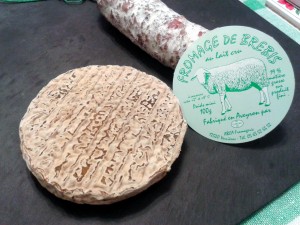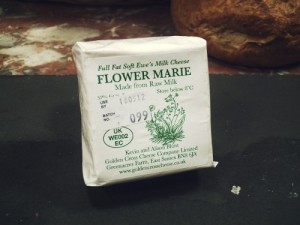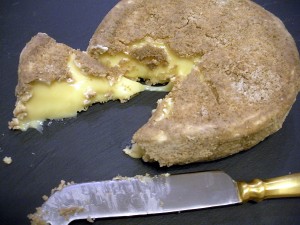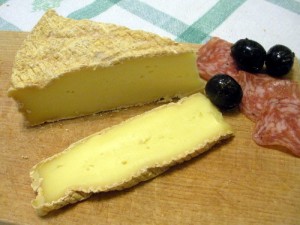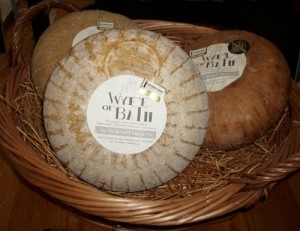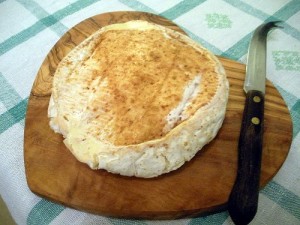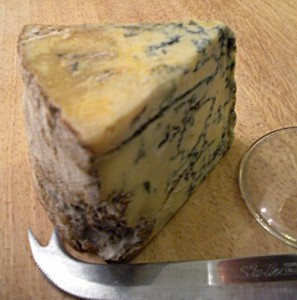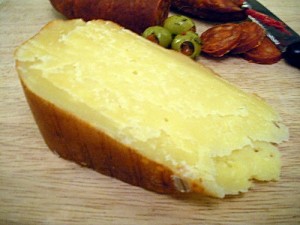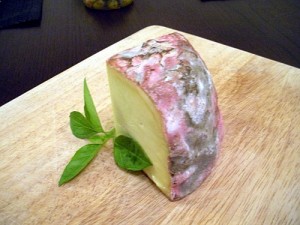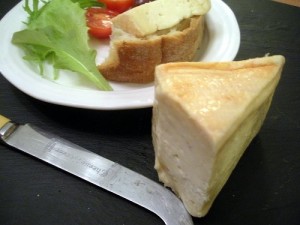Archive for the ‘3 Stars – Good’ Category
Pérail de Brebis (aged)
October 11th, 2020 Posted 3:54 pm
We found this for sale in a visiting French market. It was rather crusty and gnarly, so we had to try it.
Normally, Pérail de Bribis is a soft white delicate cheese, but this one was aged, turning into a hard, leathery disc.
The formerly white rind has turned mottled brown and beige. It smells rather like a farm outhouse.
Cutting into it reveals that it has become almost all rind, with a thin layer of soft khaki, grey pate. What little pate remains has a soft, silky texture similar to that of lemon curd..
The flavour is strong and bitter, with a burning spiciness. Not for the feint of heart cheese novice.
It is interesting and pleasant in a masochistic way. Best eaten on toasted fruit bread to counteract some of the bitterness.
Despite the seemingly negative write up, we actually rather liked it.
Reviewed by Nick and Olympia, 2019




 (3.5/5)
(3.5/5)
Posted in 3 Stars - Good, French, Sheep's milk
Flower Marie
February 24th, 2019 Posted 7:07 pm
Soft fluffy cubes of delight made in the little village of Golden Cross, Sussex.
Each Flower Marie comes individually wrapped in waxed paper, like a pat of butter. Inside is a soft, bloomy, white mould covered cube of cheese.
The outside has no real smell, save a slight mushroominess one would expect from a mould rind cheese.
The pate is a pale yellow colour and smells faintly of grass and milk. The texture is soft, creamy and fudge like with a light, delicate fresh flavour, with hints of grass and the sweetness typical of a ewe’s milk cheese.
It’s an inoffensive and well behaved cheese suitable for offering to guests, whose taste in cheese may be uncertain. Delightfully pleasant.
Produced by Golden Cross Cheese Ltd.
Purchased from Cheese Please, Lewes.
Reviewed by Nick and Olympia, 2012




 (3.5/5)
(3.5/5)
Posted in 3 Stars - Good, English, Sheep's milk, Soft, Vegetarian
Camembert au Calvados
February 10th, 2019 Posted 7:14 pm
Just when you thought Camembert couldn’t get any more interesting…
…they cut off the rind, dip it in a Calvados and cider mixture, and then roll it in biscuit crumb. How wonderful! (Calvados is a brandy made from apples rather than grapes.)
The result is this rather crusty appearance with gooey, yumminess oozing out.
The crust smells very strongly of fermenting fruit with a slight disinfectant smell about it. The pate is typical of a Camembert, pale yellow and gooey with identical creamy, sticky texture.
The taste is an interesting mix of bitter, sweet and fruity with chemical, acetone notes, a bit like pear drops and cellulose varnish. There is also, unsurprisingly, a strong alcoholic element in this mix. The strong aftertaste has a pronounced metallic quality.
In closing, it is an interesting cheese. One to impress guests with, because of it’s unusual and unique nature. As a cheese to savour and enjoy, not so much. It is a little intense, best eaten in small quantities.
Purchased from: Champagne + Fromage, London
Reviewed by Nick & Olympia, 2017




 (3.5/5)
(3.5/5)
Posted in 3 Stars - Good, Cow's milk, French, Soft, Washed
Milleens
February 3rd, 2019 Posted 6:41 pm
Now there’s a cheese that looks like a proper rustic, traditional farmhouse cheese that has been made for many generations. It is however, a relatively modern creation, first produced in 1976.
From the rugged, but lush Atlantic coast of the furthest south western corner of Ireland. The Beara Peninsular, County Cork, is home to the herd of Friesian cows that provide the milk for this cheese, giving it almost alpine like qualities.
On the outside, its course orangey, light brown rind smells somewhat like a Parisian concrete pissoir: earthy with an overpowering ammonia content.
The pate, is rubbery, soft and yielding, with a waxy feel and look. The smell is pleasantly milky with no trace of the ammonia that so dominates the rind.
The smooth, waxy texture has a mild, slight bitter edge at first bite, that quickly fades, revealing a subtle Morbier like herbaceous, alpine flavour with vague, but elusive hints of caramel that you’re never really certain were there.
All in all, it’s a good cheese. Pleasant, but not terribly exciting.
Manufactured by Milleens Cheese Ltd.
Purchased from Cheesology
Reviewed by Nick and Olympia, 2018




 (3/5)
(3/5)
Posted in 3 Stars - Good, Cow's milk, Irish, Semi-soft, Washed
Wyfe of Bath
February 19th, 2017 Posted 5:18 pm
“Experience, though noon auctoritee, Were in this world, were right y-nough to me, To speke of wo that is in mariage; For, lordinges, sith I twelf yeer was of age.”
- Geoffrey Chaucer
From whence this cheese doth get it’s name… apparently.
|
According to the manufacturer, like Chaucer’s tale, this cheese is like a taste of old England. It certainly smells, old. It has this wonderful smell of old, damp stone, reminiscent of a church crypt. Formed in cloth lined baskets, the cheese is shaped like a large round soap bar, with a tough, leathery, orange / grey, natural rind. Inside, the pate can vary from a pale yellow to a light golden colour, with a firm but yielding, slightly rubbery, but creamy texture. The taste is initially quite sharp, with delicate hints of fungus and stone. The sharpness quickly melts away leaving a pleasing nutty, grassy flavour. |
All in all a pleasant cheese to nibble on with a glass of red wine.
Produced by The Bath Soft Cheese Co.
Reviewed by Nick & Olympia, 2011.




 (3/5)
(3/5)
Posted in 3 Stars - Good, Cow's milk, English, Hard
Voluptueuse Aphrodite
October 12th, 2014 Posted 9:44 pm
We were quite excited to received this gift from some friends, when they returned from a trip to France. It is washed in Calvados and dusted with ginger (to give it an aphrodisiac effect, apparently). Oozing and collapsing under its own decadence, it promised much and we could barely wait for our Sunday cheese fest to try it.
Looks fantastic, doesn’t it?
It has a mild smell that is slightly cheesy, but nothing more. The pate is soft and gooey around the edges, but firm in the middle.
The flavour is initially sharp, especially in the firmer centre, with a slight bitterness. Sadly, we detected no hint of Calvados nor ginger, which was actually rather disappointing.
A voluptuous goddess of love!…Washed in Calvados!… Dusted in ginger!… One expects it to be exciting… provocative sensuality, velvety smooth, with an intoxicating richness and a little touch of spice. This was very much a plain Jane.
As for the aphrodisiac effects, we didn’t experience any sudden urges to drag one another to the bedroom and rip each others clothes off.
…so, it seems looks can also be deceiving in the world of cheese.
It did get better with age, becoming more like a Camembert, but still far from expectation.
All in all it wasn’t a bad cheese. A shame really, it promised so much, but failed to live up to its name.
Reviewed by Nick & Olympia, 2013




 (3/5)
(3/5)
Posted in 3 Stars - Good, Cow's milk, French, Semi-soft, Washed
Wensleydale Blue
October 5th, 2014 Posted 6:25 pm
Most people will be familiar with Wensleydale. Very white, sharp, crumbly and often found in supermarkets, flavoured with cranberries or apricot. Few will know about the blue variety, fewer still will know that Wensleydale was once always blue.
In the 14th century when Cistercian monks settled in Wensleydale, Yorkshire, they started making cheese (as monks tend to do). Having come from the Roquefort region of France, the recipe they brought was for blue cheese. Somewhere in its history, it became the white cheese we are now familiar with. The blue version is now rare.
The rind is dark and gnarled, dusted in fluffy moulds. The pate is a pale yellow with dark blue veining.
Though the smell is not strong, it is somewhat reminiscent of old socks with a hint of blue.
It is quite crumbly, though not as much as its cousin, the texture is creamy and smooth. Though it may look fearsome, it has a very pleasant mild, blue flavour, with none of the expected Wensleydale acidity and a mellow lingering aftertaste. A bit Stilton like, but not as strong.
It looks a bit uncouth, but is actually very civilised.
Produced by the Wensleydale Creamery.
Reviewed by Nick & Olympia, 2012.




 (3.5/5)
(3.5/5)
Posted in 3 Stars - Good, Blue, Cow's milk, English, Hard
Mahón Curado
June 15th, 2014 Posted 4:05 pm
With thanks to my sister, who managed to smuggle this into the country when returning from a holiday in Mallorca last year.
Deep yellow, crumbly, rubbed in olive oil and dusted in paprika. This is the mature version of a cheese from a small dairy on the northern tip of Menorca.
The paprika gives it a very appealing orangey tan coloured rind, and the way the pate flakes is reminiscent of mica.
It has a good strong cheesy smell, but nothing that makes it distinct.
Texture wise, it’s somewhere between a Manchego and Parmigiano. Dry and crumbly with a slight chewyness, together with the soft crunchiness of lactic acid crystals (or maybe salt).
The flavour is good, strong and robust, with no acidity, very similar to a good strong Cheddar.
All in all, a good tasty cheese.
Produced by: Lacto Industrial Menorquina.
Reviewed by Nick & Olympia, 2013.




 (3.5/5)
(3.5/5)
Posted in 3 Stars - Good, Cow's milk, Hard, Spanish
Francis
April 6th, 2014 Posted 8:13 pm
| What’s pink and fluffy, but isn’t pink fluff? That’s right… cheese, a cheese called Francis.
This cheese was named Francis in honour of the famous British cheesemaker James Aldridge, who’s name wasn’t James at all, but actually Francis. It was developed by another James (James McCall) who was in James’ (Francis) employ when he was a teenager. James (not Francis) is now a fully fledged cheesemaker and has his own company (James’s Cheese). Although the cheese itself is made by James Martin at Lyburn Farm. So, in summary: James makes James’ of James’s cheese Francis, named after his ex-boss Francis aka. James. – Oh, it’s so confusing Right, now we’ve got that all sorted, the important bit: Covered in dust pink, grey and white moulds. Francis is washed in the same culture that is used to wash Livarot and Munster. As a result, it smells very like them, strong and pungent. Initially, the flavour is also strong, but in some strange way, not strong, becoming mellow, but with a definite presence. The texture is soft and malleable, but with an unexpected chalkiness. Its flavour is like that of its French cousins, but at the same time not. Like the history of its creation, it is confusing and complex. |
Produced by Lyburn Farm
Purchased from Sturminster Newton Cheese Festival 2013
Reviewed by Nick & Olympia, 2013




 (3.5/5)
(3.5/5)
Posted in 3 Stars - Good, Cow's milk, English, Semi-soft, Washed
Maroilles
January 19th, 2014 Posted 7:17 pm
| From a Trappist recipe, over 1,000 years old, this distinctive sticky, orange slab is the favourite of kings, and it’s not hard to see why.
It has an attractive orange rind. But… it’s not coloured with an annatto stained wash like many other orangey coloured cheeses. This is the colour the the particular strain of bacteria that is grown on its surface. As it matures, Maroilles is repeatedly turned and washed with brine. This kills off the usual white moulds, allowing a culture of orange bacteria to develop, giving it a sticky, oily texture. It has an acrid smell, that is quite pungent, but not strong. Inside, the paste is also quite sticky and oily. A pale yellow in colour with little holes and a soft, rubbery bite. The flavour is initially, not strong, but again, distinctly acrid and slightly bitter. However, the flavour increases as you chew. Strangely, the aftertaste is stronger still. The bitter aftertaste fades and is replaced with sweet buttermilkiness. In some ways, it has a strong flavour, yet it is mild. All in all, it provides a complex tasting experience that is rather hard to describe. |
Purchased from the French cheese stall, Brighton station.
Reviewed by Nick & Olympia, 2012




 (3/5)
(3/5)
Posted in 3 Stars - Good, Cow's milk, French, Semi-soft, Washed

